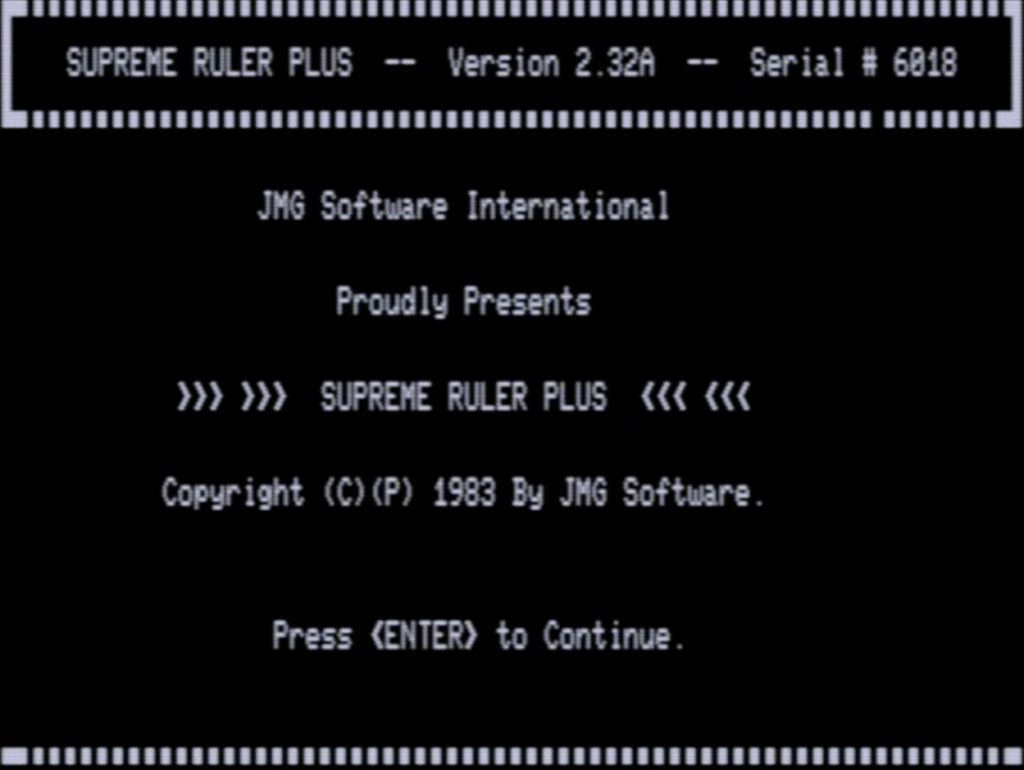
George Geczy ‘s Supreme Ruler was the flagship game of JMG Software International, a short-lived Canadian publishing company whose acquaintance I made when I covered the Battle of Zeighty.
To be perfectly honest, Supreme Ruler is not really a wargame ; it is a tycoon comparable to Hamurabi and even more to Santa Paravia en Fiumaccio, except with a modern setting and a warfare module. George Geczy also pointed me, as a reference, to a 1981 Peter Trefonas game called Empire, which had escaped my attention so far.
In any case, I am not sure I would have covered this game normally, but :
- Supreme Ruler is the oldest “computer game licence” still active, with Geczy ressurecting the name in Supreme Ruler 2010 (released in 2005) and since then releasing 4 more Supreme Ruler and counting,
- It is the one of very first computer games I can track (PLATO excepted) that combines complex economy and unit building, the only earlier attempt I can think of is Galactic Revolution, which fell flat on its face,
I would not call the game Grand Strategy, as it is missing the diplomatic aspect. There are several “countries”, but in single-player they cannot coordinate and they will attack one another. As the game lets you name your country and the AI countries, and as I wanted my AAR to be a minimum grounded in reality, I decided to pretend this all happens in one of the few regions of the world where it would not be out of character for a country to attack a neighbour the first year, and then a second neighbour with the help of the first one the following year…
… the Balkans !
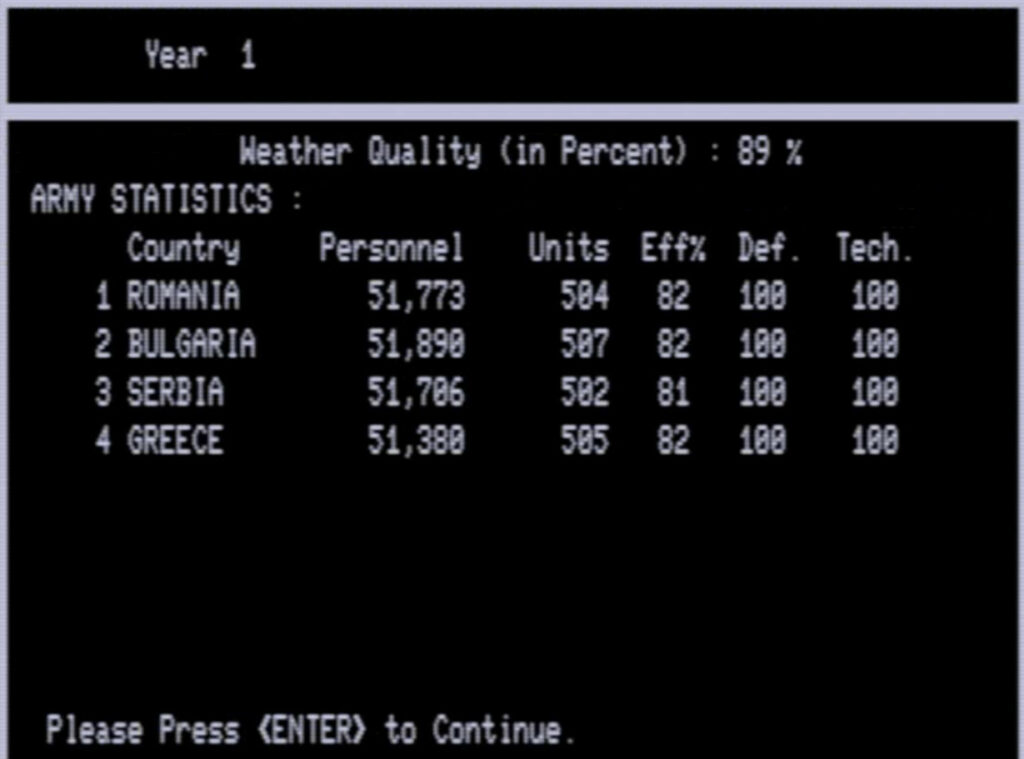
I am going to play Romania, against 3 AI opponents : Bulgaria (set to “aggressive”), Serbia (“balanced”) and Greece (“defensive”).
Each turn, the player takes a string of economic decisions :
A. Tax rates

There are 4 tax rates you can tweak :
- Corporate Tax harms your industry, including defense and agriculture,
- Income Tax makes people unhappy, after which they leave your country. People double up as manpower, so you really need people around,
- Sales Tax harms both industry and happiness, but less so than Corporate Tax and Income tax
- Import Duty also affects industry and happiness, but as the manual states, “this rate will not affect your economy as much as any of the others, unless it is very high“.
The game expects you to balance the four taxes, but in my experience, it is very hard to compensate for the negative impact of taxes on industry (you need to subsidize them, which means you lose the money) whereas you can compensate for unhappiness by massive food distribution (which is kind of free) and my high social spending – so taxing the people is going to be exactly my strategy.
So I decrease the Corporate Tax from 30% to 20% and increase the income tax from 30% to 40%
B. Food supply
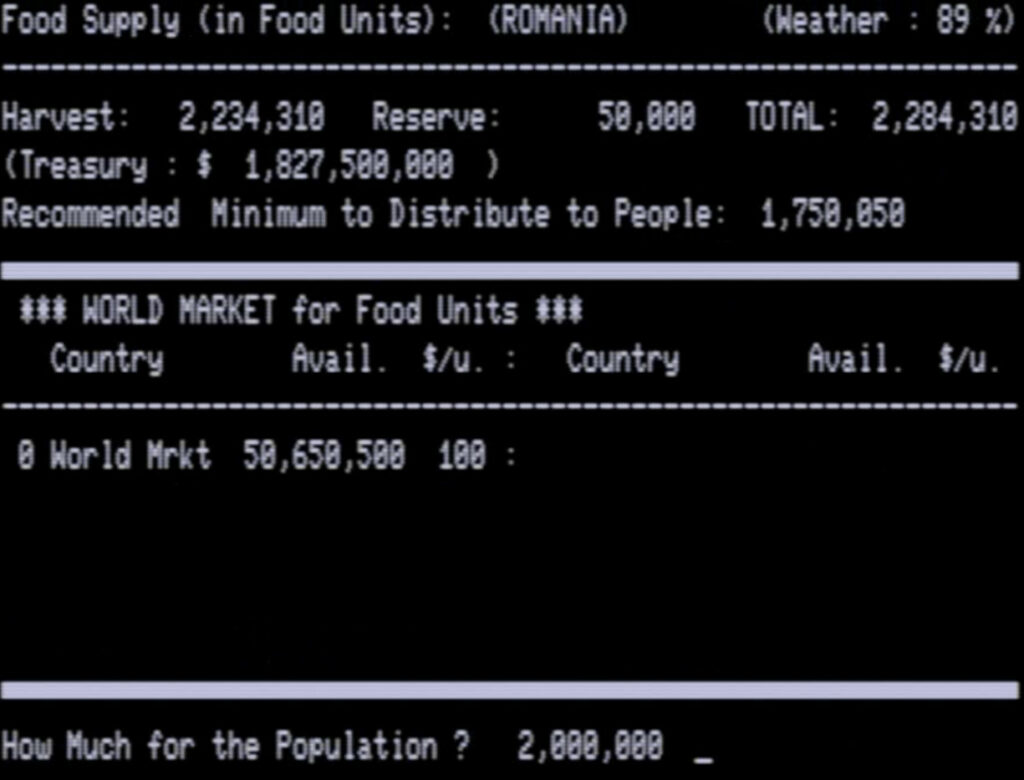
That’s the second part of my strategy. I want my people to be happy, so I give them more food than they need. I don’t pay for the food, so I guess my regime is kind of neo-feudal ? I mean, it can’t be communist – how many communists do you know who would decrease “corporate tax”?
C. World Market Loans

Wait, people trust me enough to loan money to my new and untested government ? Nice. The interest rate makes it look like a scam, but I want the money to kickstart my economy, after which I will easily repay back. I hope, anyway.
D. Government services
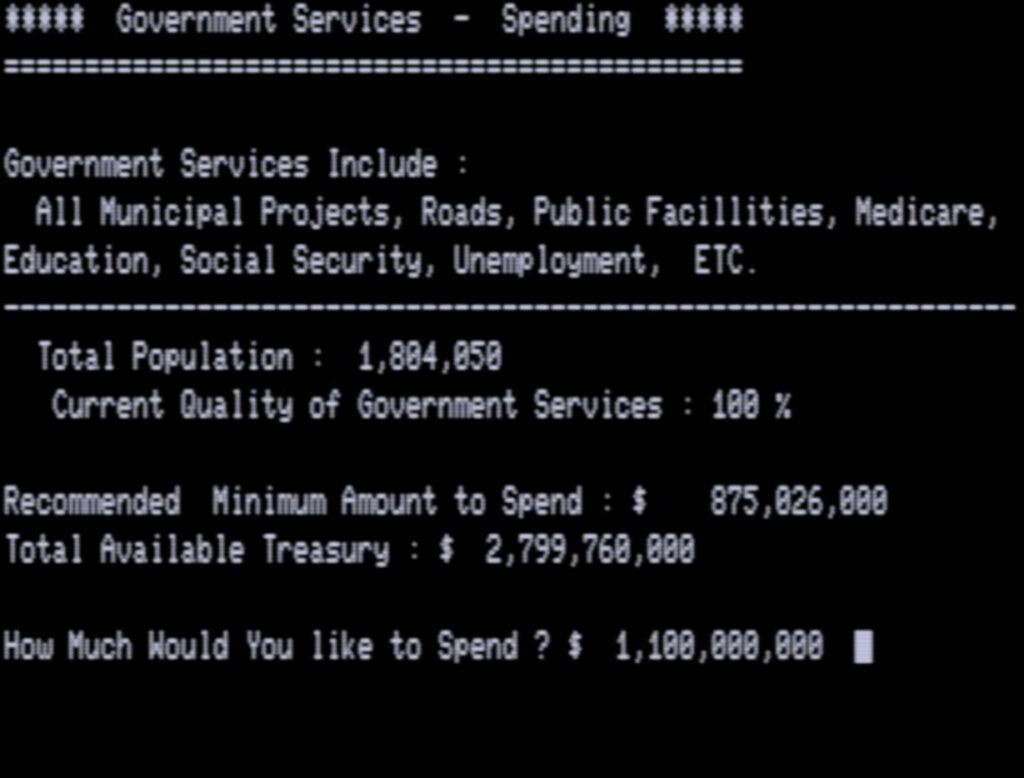
They ask for $ 0.9B but my people deserve better, so let’s add a more than 20% gratuity to that ! Protecting the peasants people is one of the neo-feudal duties of a neo-Lord, after all.
E. Subventions

I don’t really use this screen. Agriculture is “organically” subsidized by me distributing all this food. “Other” and “Defense” is “organically” subsidized by the low taxes.
F. Defense
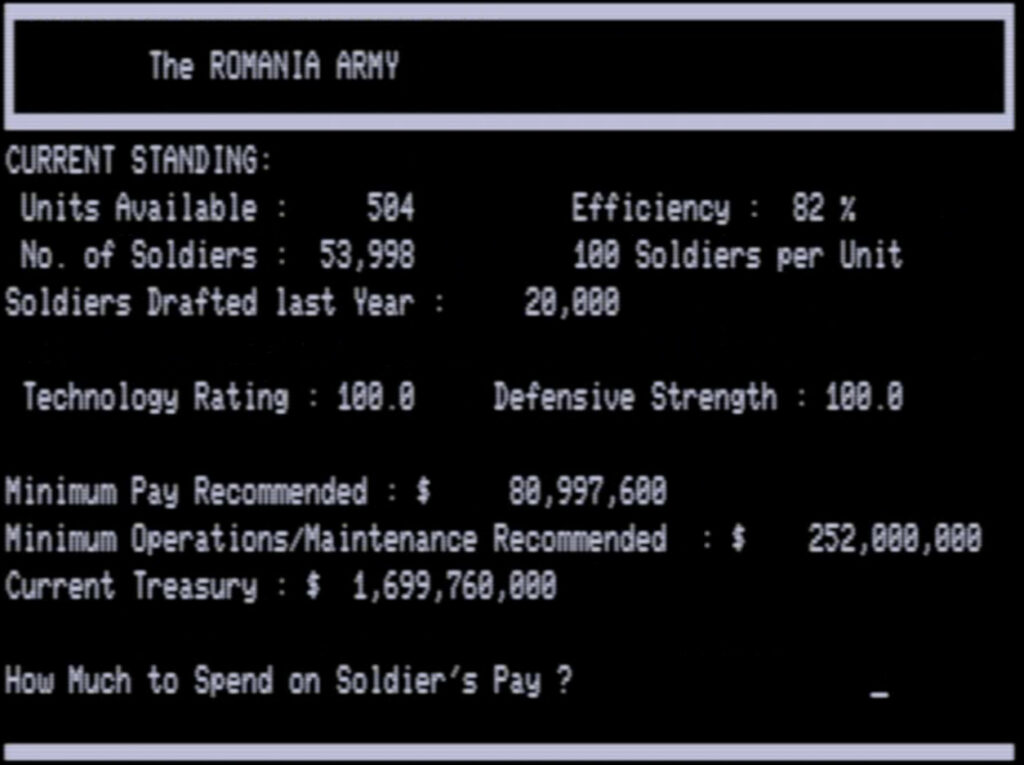
Aaahh ! The one menu you were all waiting for. The game asks you to allocate the rest of your budget between :
- MInimum Pay : Paying above the minimum increases the number of volunteers ; meh, for now my
leviessoldiers are paid enough, - Maintenance : Paying above the minimum increases the efficiency,
- Research & Development : Weirdly, this decreases the number of soldiers necessary to create a unit,
- New equipment : Having soldiers without equipment is useless. To create a unit, you need to invest 2 millions in equipment in addition to the number of soldiers that your level of R&D requires,
- Defense : This is a long term investment that will decrease the damage received when attacked by another country,
I don’t care too much about efficiency, but I care a lot about R&D, as I don’t want to draft too many people in my little corner of paradise (for some unfathomable reasons, being conscripted apparently makes people unhappy) so that’s $500M of R&D. I also buy 150 units that I consider necessary to resist enemy attacks, and invest the rest between maintenance and defensive strength.
G. Offense

In that menu, I pick which country is going to be on the receiving side of Romanian wrath. Sadly, I did not include Hungary in my game, so it is going to be for Bulgaria. Bulgaria having an “offensive” AI, I know it will deplete its defence to attack…well, someone, and hopefully not me. I can just use the opportunity to seize some Black Sea coastline for cheap.
All the attacks are resolved at the same time. Bulgaria decides to attack Greece (without success) so guess who receives a few new chalets near Varna ? Romania !

And … that’s it for the year !
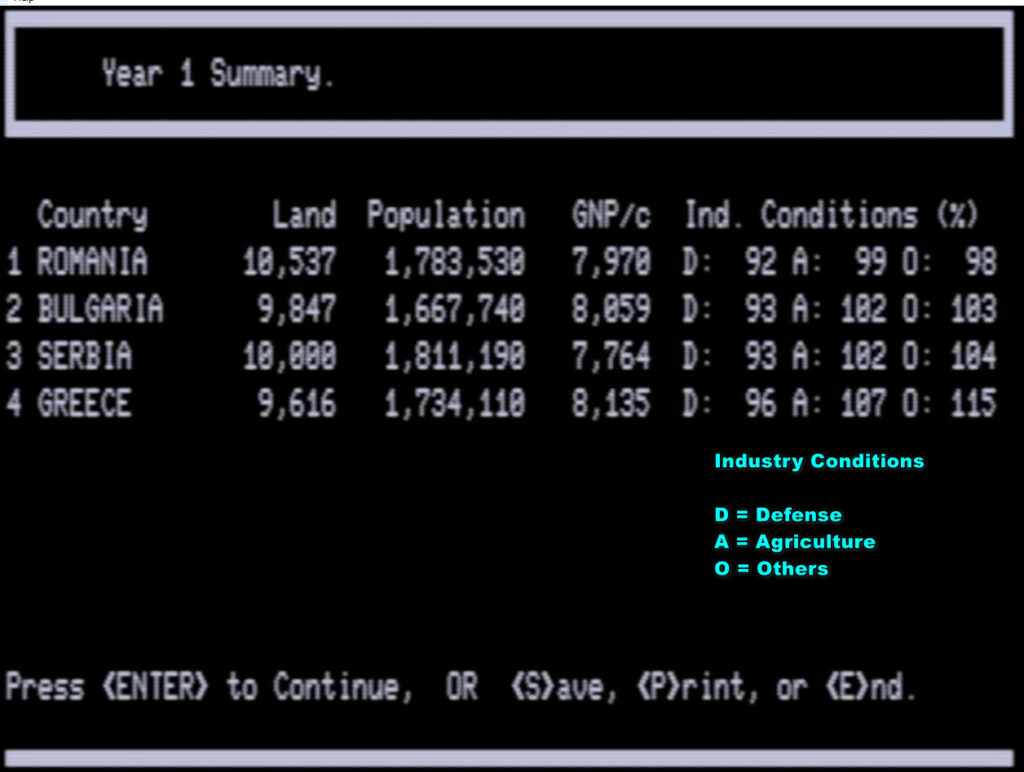
My generosity to my people allowed my population to grow by a solid 8% already, thanks to immigration :
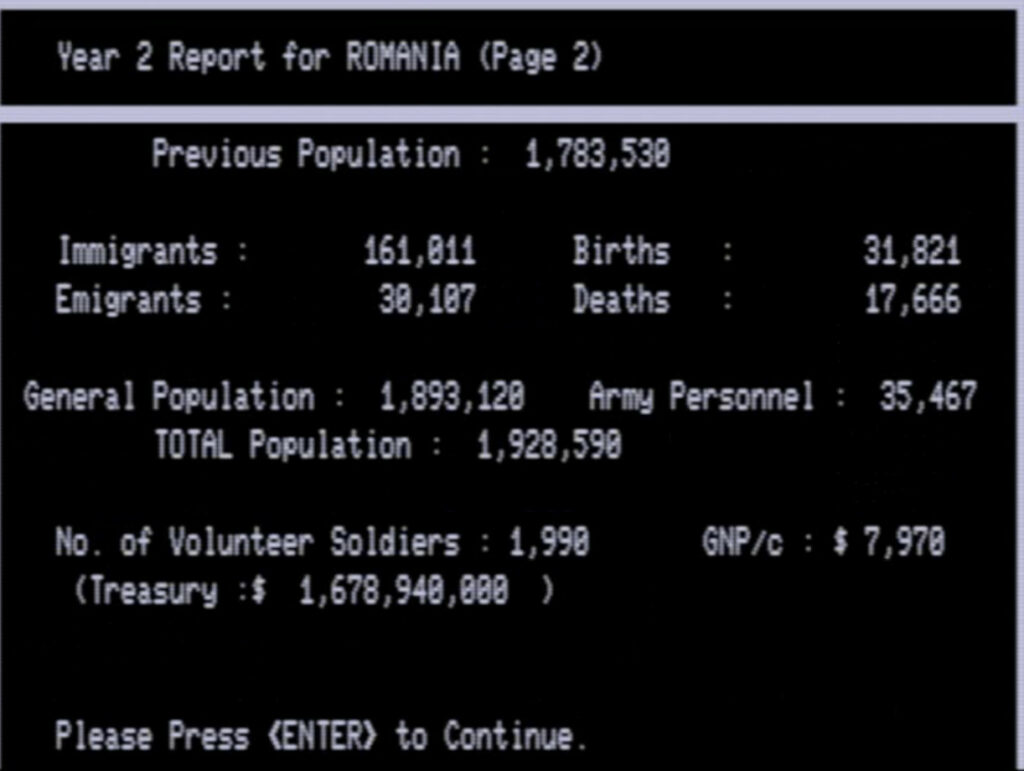
Unfortunately, the following years don’t go as well as expected for Romania. The increased income tax doesn’t compensate for the decrease in corporate tax, and the debt burden is crippling the national revenue.

Worse, bad weather generated bad harvests, and there is little surplus to distribute. Ultimately, the loser is the army. As the Romanian government is trying to pay its crushing debt while still paying for superior social service (lest my strategy collapses), the budget of the army moves from $1.7B the first year to $0.4B the second and third ones. Just enough to maintain a defensive force. Bulgaria will wait.

Luckily, no one attacks poor, innocent Romania in those difficult years : instead Serbia and Bulgaria gang-up on Greece. After Serbia destroys the Greek army, Bulgaria just jumps in and seizes a large amount of Greek soil :
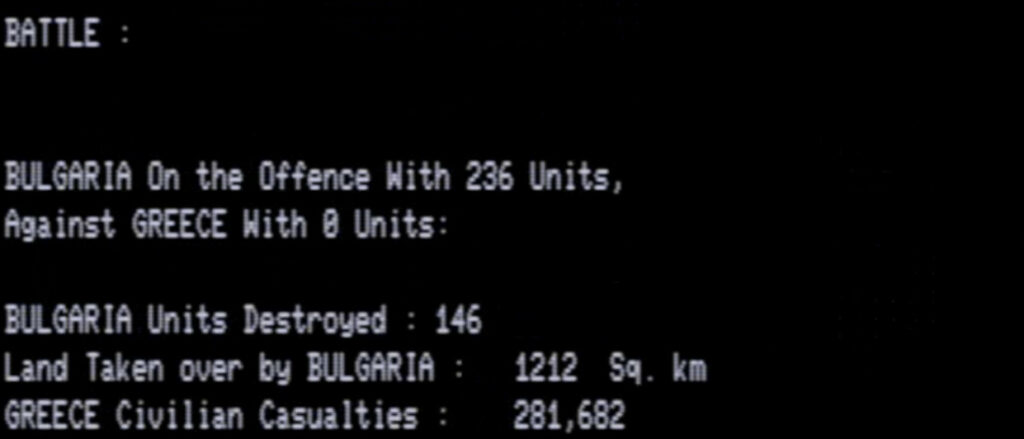
Eventually, by year 5, the years of sacrifice, fiscal conservatism and sheepish international policy paid-off : the debt is mostly repaid, the country is the most industrialized in the Balkans, with high agricultural productivity allowing the distribution of a massive surplus. Immigrants flocked to Romania, where food was free, the State provided a lot of services, and conscription was non-existing.
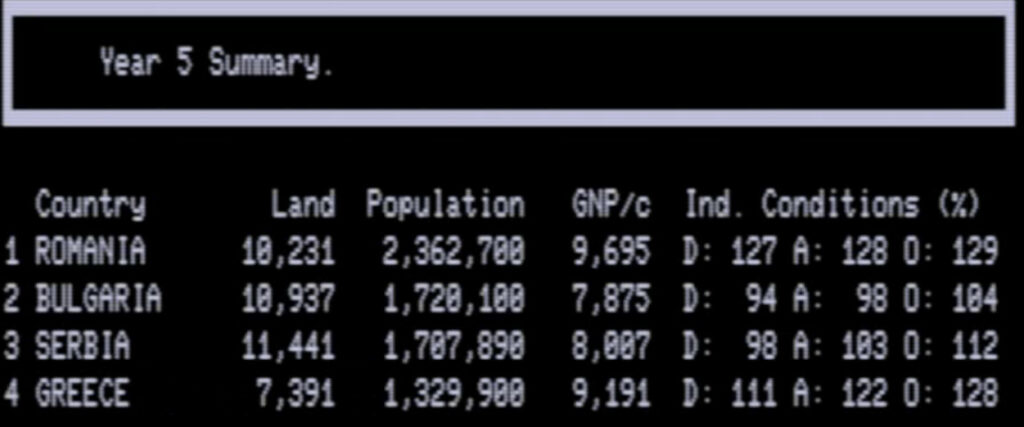
The immigrants couldn’t know it, but the latter would not last. In year 6, Bulgaria, Serbia and Greece all jump on the peace-loving Romanians, and I lose all my armies, some population and all my Black Sea resorts :
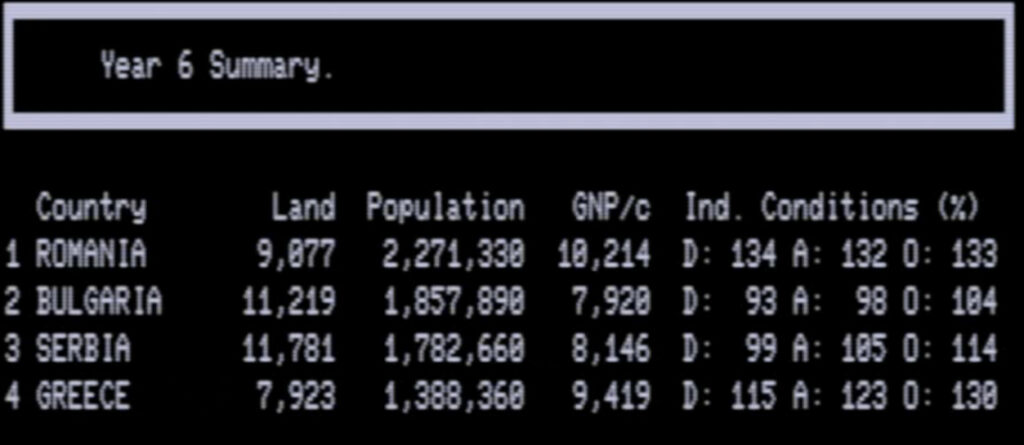
I am not happy about this development. The Romanian neo-feudal Revolution is under siege.
Unfortunately for my neighbours, my budget is now $3.2B a year, 50% more than any other country. I push conscription to the maximum, invest massively in my army and pick my neighbour with the smallest army – it turns out to be Serbia. What do you know, my historians just realized that the historical Dacian capital Sarmizegetusa was in the middle of Voivodine after all, and Serbia is occupying multi-millennial Romanian clay.
Attacking in year 8 with 400 units, I crush the Serbian army and claim 20% of Serbia. Smelling blood in the water, Bulgaria also attacks Serbia in the following year while I rebuild my armies, and then it is my turn again along with Greece, and then me again year 11 after my historians find out that Decebalus’ tomb was actually in Belgrade.

Meanwhile, economic and population growth carried on, and Romania is number #1:
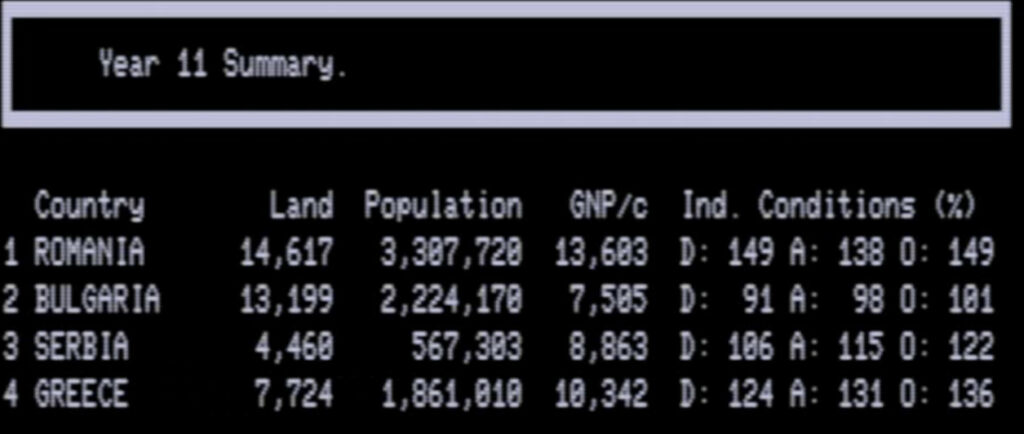
Year 10, all my tax rates except Income Tax are set to 0%, and still my budget is equivalent to the one of Bulgaria and Greece combined – Serbia is a non-entity.
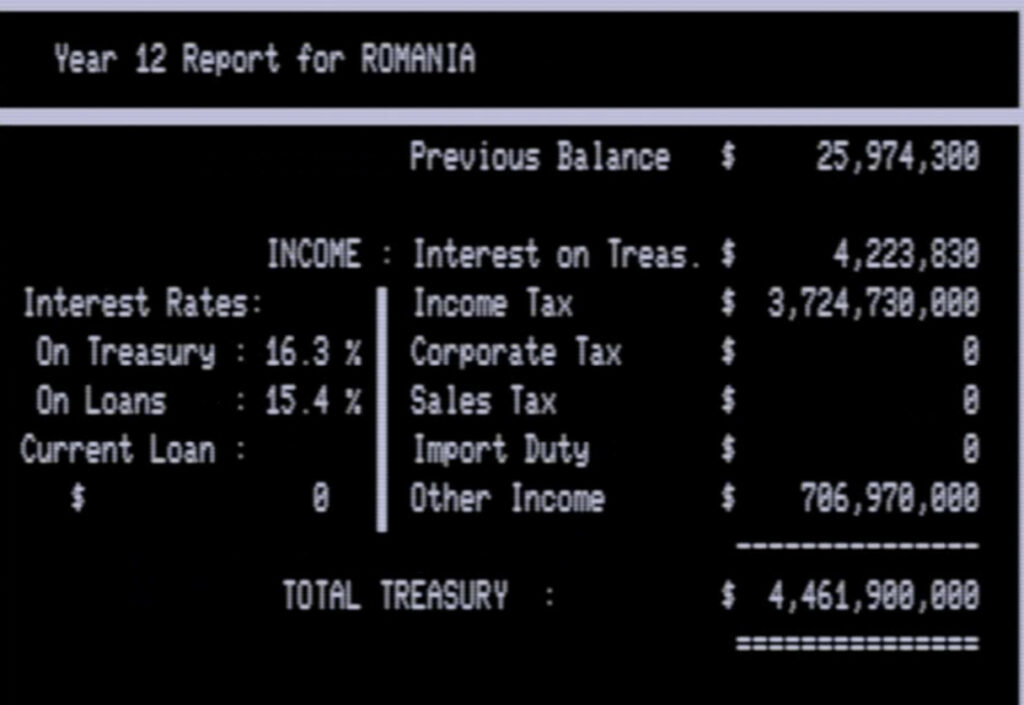
My agricultural surplus and my size allow me to generate an insane amount of food, which I distribute to my population :
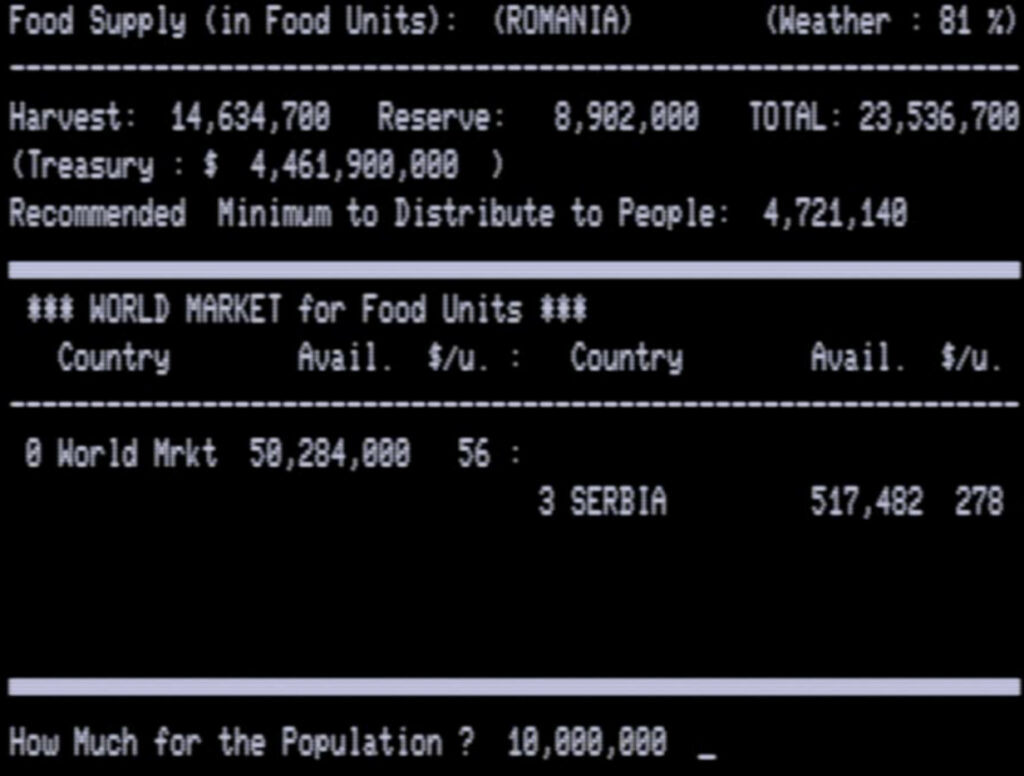
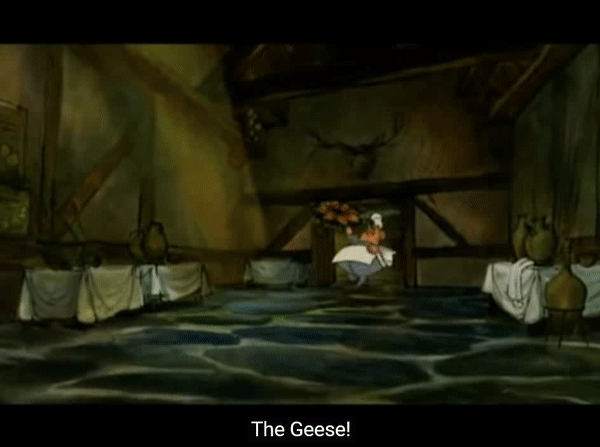
This makes everyone want to become a Romanian, and consequently, I receive 1.4 million immigrants in a year, ca 40% of my population.
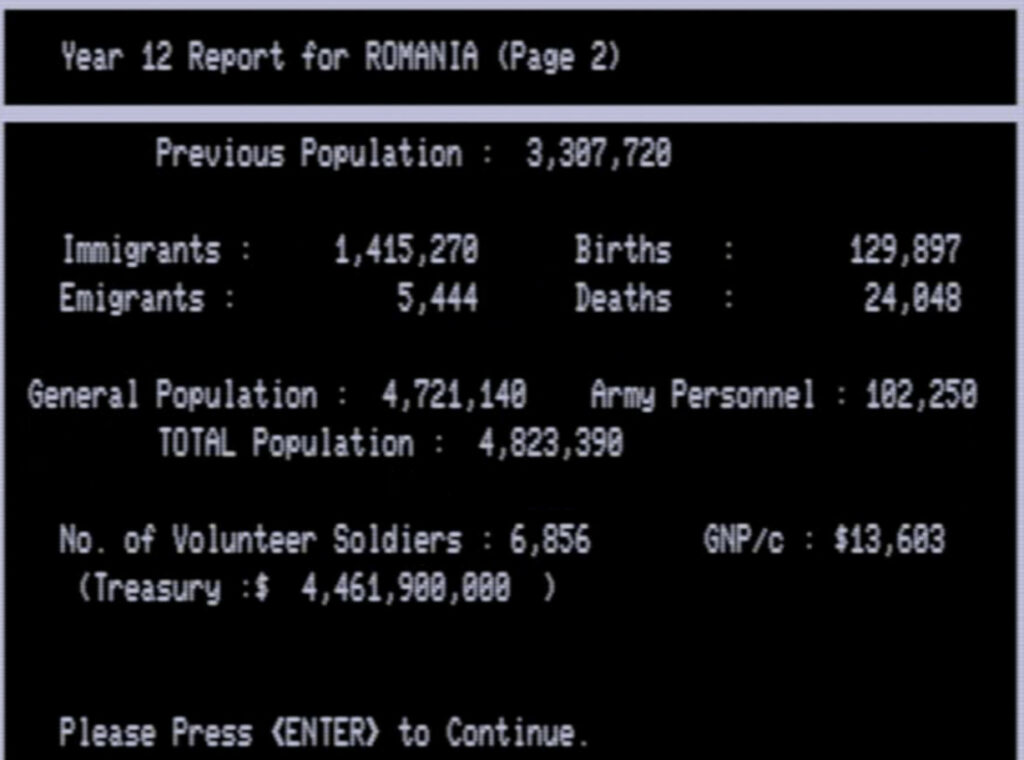
Of course, those people will generate a massive amount of income tax, allowing me to fund massive social services (even if their base cost increases), which in turn will trigger massive immigration – I basically broke the game.

I execute Serbia in year 14 :

At this point, I can easily defeat both Serbia and Bulgaria combined, and still they fight each other from time to time. Ah, Balkans, Balkans never change.
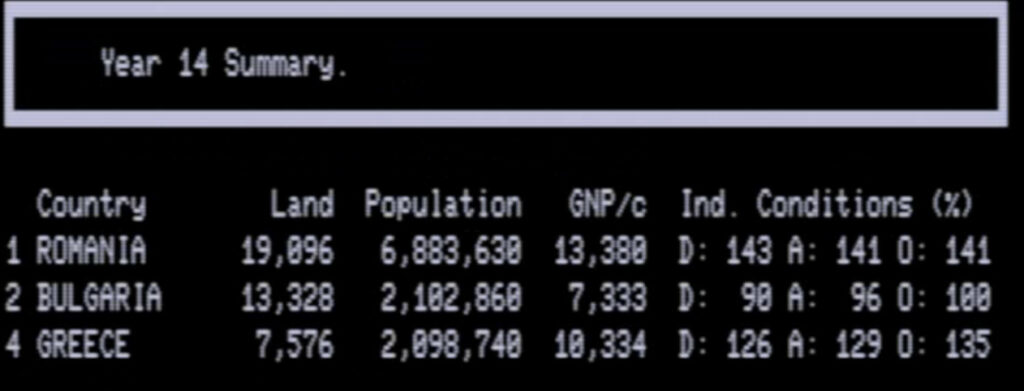
From year 15 to the end of the game, my armies are sized in thousands of units, whereas my enemies usually have 400 units at best. I annihilate Bulgaria year 18 (“we found out the Thracians and the Dacians were the same people after all”), and finally Greece (“Remember the Phanariots !”) turn 20.
The last battle :

And the victory screen :
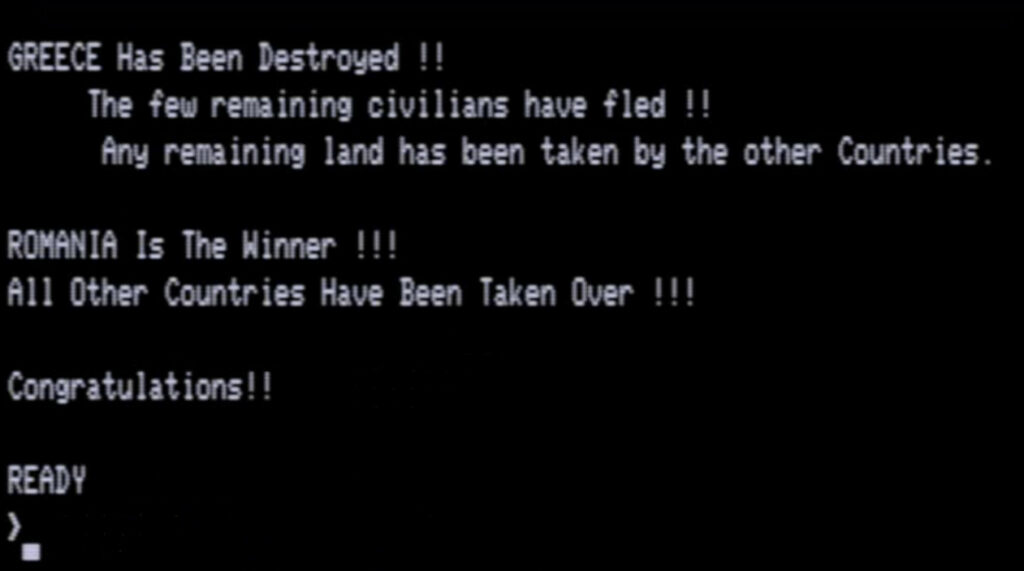
That year, my budget was $30B, and I received 4.3 million migrants.
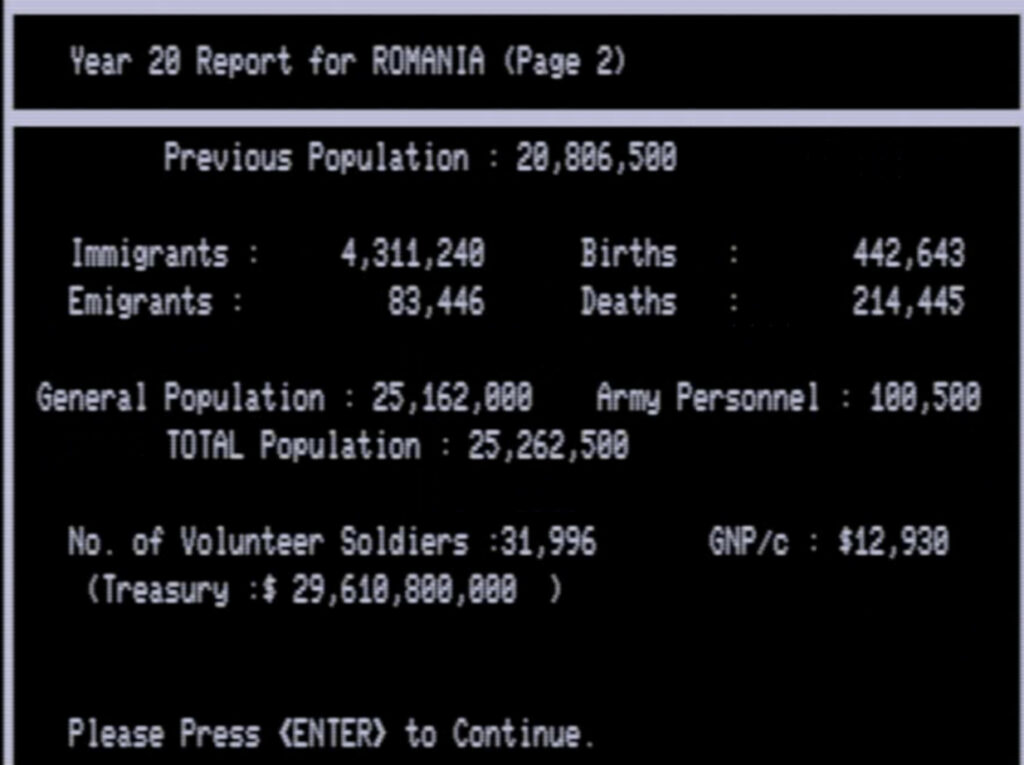
The year is 1934. the Romanians look across the Adriatic. The land of their other ancestors is there, waiting to be liberated…
Rating and Reviews

Supreme Ruler, by George Geczy (Canada), published by JMG Software International
First release :
Supreme Ruler : November 1982 on TRS-80
Supreme Ruler Plus : May 1983 on TRS-80
Tested on : TRS80GP emulator,
Total Hours Tested : 3 hours
Average duration of a campaign: 1 hour against 3 AI opponents
Difficulty: Easy (1/5)
Would recommend to a modern player : No
Would recommend to a designer : No
Final Rating: Flawed and obsolete
Note that I played Supreme Ruler Plus, not Supreme Ruler. Both games are extremely similar, but Supreme Ruler Plus adds :
- Save / Load feature,
- A few customization options at the beginning of the game,
- More detailed reports,
- Smarter AI, and the possibility to choose an “AI profile”,
- A nice manual,
A. Immersion
I had an hard time getting immersed into the game. The economy is a weird combination of modern (“corporate tax”) and content pulled straight out of Hammurabi (“free food distribution & storage”) and it is easy to break. There are very few random events giving “life” to your country (it happened once in my Romanian game, and 4 times in total in my 3 hours of playing the game) and of course there is no art at all.

At least, the manual is well-written and quite fun to read, which is a feat given how dry the game is.

Rating : Terrible
B. UI , Clarity of rules and outcomes
Obviously, the only “UI” is text, so as a player you will only answer Yes/no, input numbers and pick targets for your attacks. I have played enough TRS-80 games to fear this part, but it works really well : inputs are not eaten, if you just press “enter” the game considers you typed a default value that makes sense, and you have a shortcut to write “000” in one tap.
The rules are well explained, the different screens give all the information you need, and while the outcomes are not always as expected, this seems normal for games where you manage an economy.
As a bonus, the game has options to have less detailed reports or to change the way you input numbers, so George Geczy went the extra mile to make the game comfortable to use.
Rating : Quite good
C. Systems
I tried to explain the system as much as possible without being boring in the AAR. One thing that I did not explain but deserves mention is how warfare is balanced :
- Armies are expensive to maintain at a high level of readiness,
- Even failed attacks kill enemy population and capture some land, you cannot lose population or land yourself if you fail at an attack,
Together, those two rules mean that you cannot just hide your head in the sand and wait to have a massive army – a large army will cripple your economy (except if you “broke” it with the immigration & income tax trick as I did), and a defensive posture while growing your economy will see your country slowly eroded away even if you do not lose any battle.
Another interesting balancing feature is that the largest attack is solved first (except if this default ruled is changed in the customization settings) so “smaller” attacks may be very successful if you happen to pass just after a large attack which left the enemy totally devoid of defence.
I like a lot less the total absence of AI diplomacy, and how fickle some parameters are, in particular army efficiency and industrial development can grow or collapse in one year. These issues stop you from having a real long term strategy, since anything you do can be ruined by the randomness of AI attacks.
Rating : Poor
D. Scenario design & Balancing
There are some customization options (including direct bonuses you can give to the AI), but let’s immediately talk about the elephant in the room : how exploitable the game is. There are two “sources of taxes” in the game :
- Industry : tax on the industry will limit industrial growth, which can only be compensated by subsidizing the industry. Industrial growth is also slow and fickle, so balanced overall,
- Population : tax on the population will make population unhappy, but there are many ways to compensate for this, three of them (distribution of food, limited conscription, general industrial development) being “free”. With no hard limit on immigration, it is possible to achieve exponential population growth, which will feed exponential income tax growth,
The limiting factors to population growth should have been the amount of land to grow food from, but not having taxes on industry/sales/import allows the “agricultural industry” to grow so much that productivity easily keeps up with population growth. Similarly, the need to draft soldiers can be reduced massively by R&D – at the end of my Romanian run I needed 10 soldiers by unit. In any case, once you have several million inhabitants, you only have to draft a small part of your allowance and this keeps everyone happy.
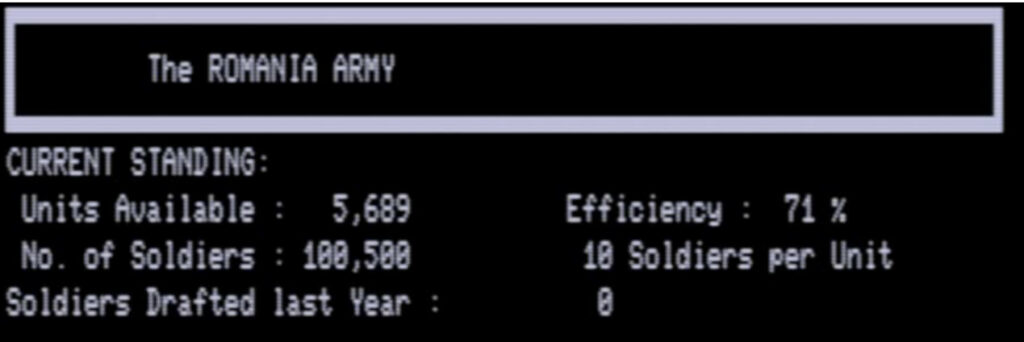
The AI simply cannot keep up against this, except maybe if I chose the customization option “only attack human players”, but if I did that the game would feel more like a puzzle than a wargame (“how to survive long enough for the income tax/immigration combo to gain momentum“).
Rating : Terrible
E. Did I make interesting decisions
Not many, and only in the very first turns.
F. Final rating
Flawed and obsolete. Sadly, just like Galactic Revolutions, the game fails on its balancing, not on its core premise. Nonetheless, I suspect that Supreme Ruler was a lot more fun than Galactic Revolution as a hot-seat multiplayer game… provided, of course, the players set up some house rules.
Contemporary Reviews
I could only find one review of Supreme Ruler, in the 1984 “Omni Complete Catalogue of Computer Software“. The catalogue states the “engrossing” game is “a class of its own, it provides hours of challenging play and for a moderate price”.
George Geczy told me that the game did not have “significant” sales, as it was released too late : “releasing on the TRS-80 in 1982 was the point where most publishers were leaving the TRS market and looking towards the new IBM PC. Distribution on the TRS-80 was also difficult because other computer stores didn’t carry the hardware and Radio Shack didn’t carry much third-party software. So we ended up self-publishing by mail order, and shoring up our revenues by selling other publisher’s software as well.” This strategy eventually made JMG Software International (later JMG CompuShoppe) the largest reseller of TRS-80 software (games or not), second only to Radio Shack itself.
Supreme Ruler’s Legacy
As stated in the intro, Supreme Ruler is still alive nowadays. The more recent Supreme Ruler games (now developed by BattleGoat Studios, the company George Geczy co-founded in 2000 with David Thompson) still follow the version numbering of the original Supreme Ruler : Supreme Ruler (1982) was version 1, Supreme Ruler Plus was version 2, and the Supreme Ruler Next Generation BattleGoat Studios is working on will be version 12.
I had played Supreme Ruler 2010 some 15 years ago, back then I had no idea that the licence was so ancient. My overall opinion was that it was a Paradox-like game ; think Europa Universalis or Heart of Iron, except not as pretty and a lot more sandbox. I bought and had a look at the latest iteration : Supreme Ruler – The Great War, and checked how Romania is doing in 1914 in that version :

Hey, maybe I will get around trying a “special AAR” where I try to annex Serbia, Bulgaria and Greece once again in this modern version – or if someone wants to try that I would host it with great pleasure.
On another topic, I have almost finished covering my backlog of TRS-80 games… but this is only because the documentation is missing for a lot of them, despite the tremendous work of Ira Goldklang. I am particularly interested in the manuals of the Synergistic Solar games :
- Parsector V and Parsector 8,
- Hypergate Patrol,
- Hypergate Centurion,
From the little I read and tested those games, they did some things that no other games were doing at the time, so if you happen to have the documentation for these games, please send a scan to either Ira or me, that would be wonderful.